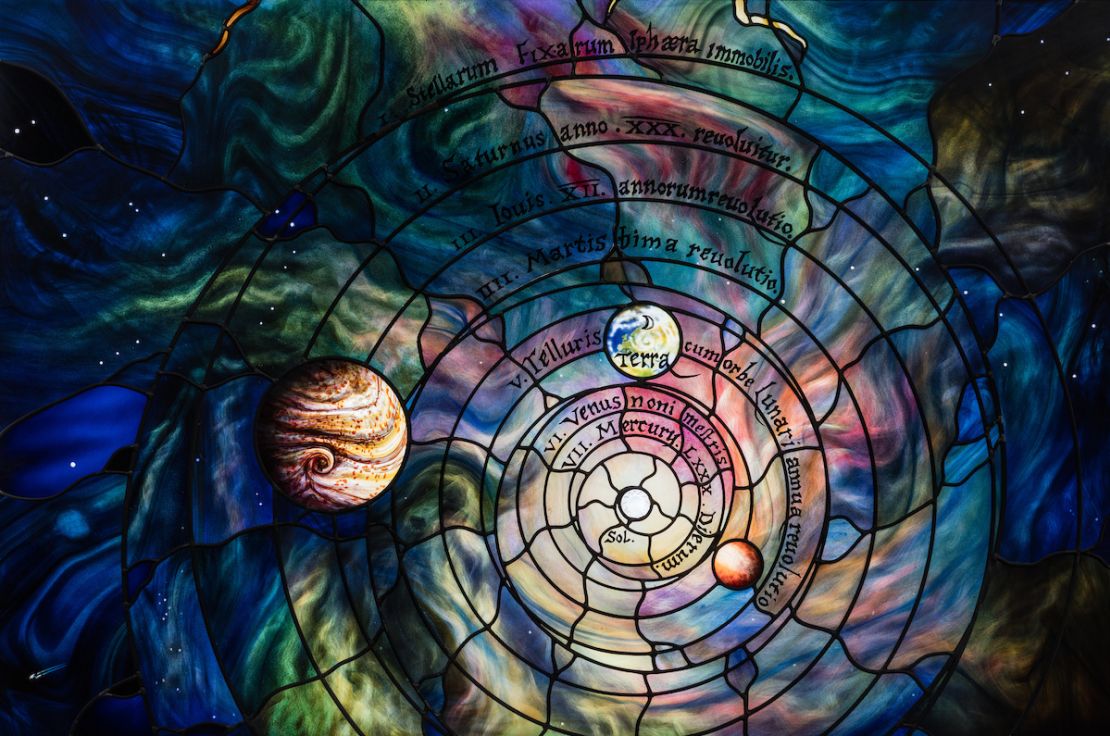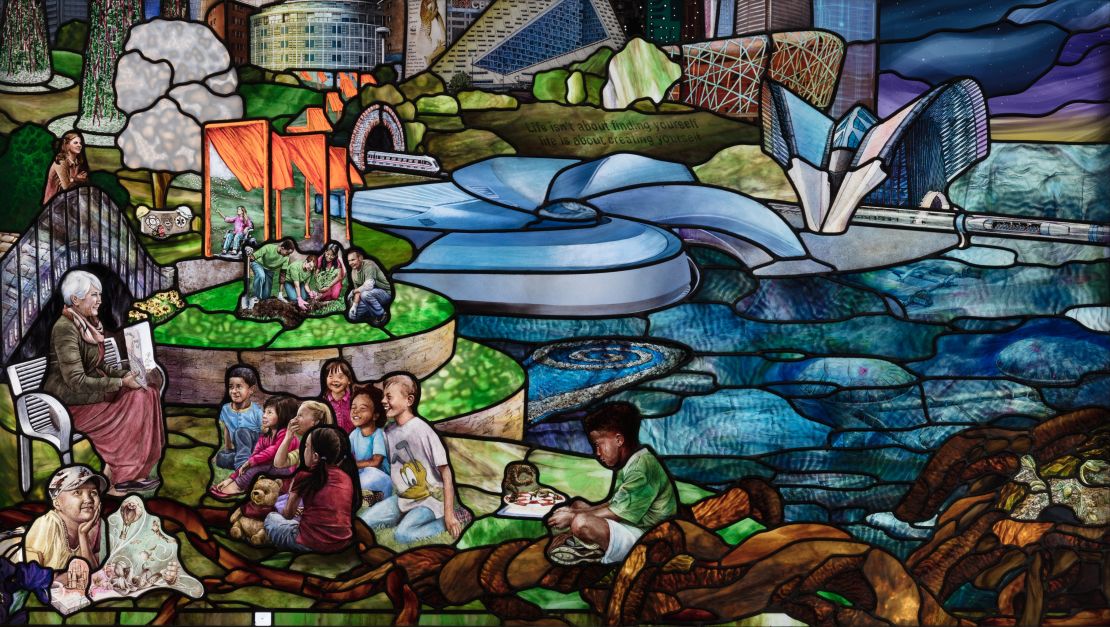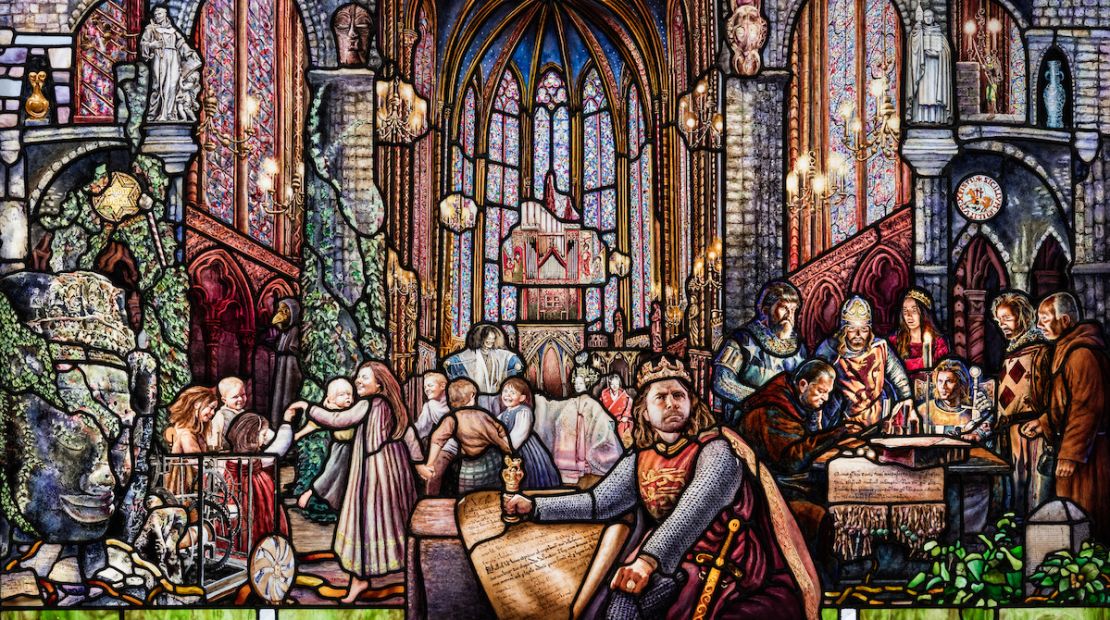Editor’s Note: Natasha O’Hear is a lecturer at the Institute of Theology, the Imagination and the Arts (ITIA) at the University of St Andrews. She is co-author of Picturing the Apocalypse: The Book of Revelation in the Arts over Two Millenia. Oxford University Press.
Story highlights
A $4.5 million, 80-panel stained glass installation called 'Roots of Knowledge' has been unveiled at Utah Valley University
Made using over 60,000 pieces of glass, the artwork took 12 years to complete and depicts the evolution of knowledge
“Make it bigger.”
These were the instructions given to stained glass artist Tom Holdman, at the start of his work on “Roots of Knowledge,” an eighty-panel stained glass installation commissioned by Utah Valley University (UVU) in Orem, Utah.
Recently unveiled at the brand new UVU Fulton Library – which was purpose-built to accommodate the panels – the $4.5 million work of art uses 60,000 individual pieces of glass to explore the evolution of knowledge and the common origin of humankind.
Holdman, who has a severe speech impediment, says he uses art as an alternative way of “speaking to people.” “Roots of Knowledge” is a much larger, more inclusive project than his previous work, which has included windows for many Mormon temples.
“Roots of Knowledge shows that this world is secular and also spiritual and how it all works as one because we all come from the same roots,” Holdman says.

A ‘tour de force’
Over a decade ago, Holdman approached the president of UVU, Matthew Holland, with an idea for the project.
Watching passers-by either engrossed on their phones or staring hurriedly at the ground, he says he was struck by how easy it is to feel small and insignificant in our modern age.
“I wanted to find a way to inspire others about how important the individual is and see how, if others have made a difference, why can’t you also?” the artist says.
The resultant windows – which took a collaborative team of over 40 artists, 350 students and 25 UVU professors twelve years to create – are indeed inspirational.

Described by the renowned curator of ceramics and glass at England’s V&A Museum, Terry Bloxham, as a “tour de force,” they consist of more than eighty panels, bookended with two life-size depictions of Methuselah trees.
The branches of these ancient trees weave their way throughout the stained glass panels, symbolizing the interconnectedness of humankind and nature.
The interior panels, equally spectacular, are comprised of 24 smaller glass panes.
Covering over 200 feet (60 meters) of wall space, they bring to mind the opulence, wonder and sheer quantity of the stained glass windows of Cologne Cathedral in Germany, Sainte-Chapelle in Paris and York Minster in England.

Often referred to as the ‘bibles of the poor’, these religious works of art helped to tell stories from the Old and New Testaments and were intended to illuminate and reflect the glory of God for their audience.
But while the “Roots of Knowledge” makes allusions to twenty-five world religions, and includes the major achievements of Hinduism, Judaism, Christianity, Islam and Buddhism, Holman insists religion is only part of the story, not the focus.
The history of glass
Holdman also taps his own artistic roots in the project and incorporates references to the history of glass.
From Greek mosaics to medieval and Victorian stained glass and the American opalescent movement of the late 19th century, numerous different styles and practices are depicted and used in the work.
Other artifacts that have found their way into the work include a fragment of the Berlin Wall, ancient fossils, a 3,000-year-old coin and part of a dollar bill.

A replica of the oldest known example of a stained glass window – which comes from Monkwearmouth Jarrow in England and dates from around 674 AD – is also included, while glass used by NASA is incorporated in a panel that commemorates the US moon landings of 1969.
Knowledge illuminated
History for purists this is not and the style and concept of “Roots of Knowledge” won’t be to everyone’s taste.
The historical narrative is Anglo-American in its emphasis and perhaps passes with too much ease over the horrors of slavery and colonialism.
It also brushes over the low points of the 20th century, with its descent into Nazism and other authoritarian terrors.

But there is something inspired about using stained glass in this way.
As a medium which both relies on light and which changes color as the day unfolds, it illuminates different facets of history and achievement depending on the time of day or the season.
The fact that “Roots of Knowledge” is set in a university library and not a chapel is also significant; it reflects depictions of such achievements into a space of knowledge and discovery.
At a time when global politics is increasingly divided – and the rest of the world looks on with some skepticism at America’s current choices – this is a work which embodies the nation’s best qualities: excellence, entrepreneurship, ambition and optimism.
Crucially, it’s also a testament to the power of the image not only to illustrate but also to illuminate and, as Holdman had hoped, to inspire.















